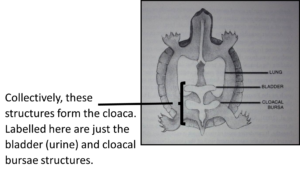TURTLES CAN DO WHAT?!
As is often the case in biology, if you hear of some weird phenomenon, there may well be a sound scientific basis for what you are hearing. The details and facts often get scrambled over generations and across cultures, but sometimes there is a grain of truth at the core. So, have you ever heard someone say: “Turtles can breathe out of their butts?”
Well, in fact, they cannot do so because lungs are connected to the trachea and mouth and nose. There are no lungs in a turtle (or anything else’s) butt. But, let’s not dismiss everything so quickly! What is going on with turtle butts that generated such a bizarre idea? The answer is cloacal bursae. All reptiles, including birds, have a cloaca which is a single opening in the body out of which flow digestive wastes (feces), nitrogenous wastes (urine), and reproductive products such as sperm, eggs, or live-borne babies. Male mammals have two openings, with urine and sperm sharing one conduit and feces in the other, while female mammals have three separate openings.
Back to turtles. In some turtles, there are two sac-like extensions on the sides of the cloaca, lined with tiny finger-like villi (very similar to the ones in your intestine) that are loaded with blood vessels; these serve to exchange oxygen and carbon dioxide between the bloodstream and the water. These turtles will expand their cloacal opening (or “butt”) and draw water into the cloaca and shunt it into the bursae where these gases are exchanged. So, this is not breathing, because breathing involves air and lungs. Rather, these bursae are functioning just like gills do in fish. I said “functioning like” because turtles obviously do not have gills like fish do have. This turns out to be a very handy function for turtles that, for example, are trapped in a pond under a layer of ice all winter. They can’t reach the surface to breathe, so they rely on these pseudo-gills in their butts!
Cloacal bursae also function in buoyancy control, in the exact same manner as submarines pump water into or out of ballast tanks. Many freshwater turtles have cloacal bursae, but not all freshwater turtles! Turtles that walk on the bottom more than swim (e.g., snapping turtles) don’t have them (too bad, because they would be useful for gas exchange, regardless of buoyancy!). Most freshwater turtles that actively swim a lot tend to have them. Softshell turtles are a big exception. They don’t have them, and I can’t explain why not. But, at the Zoo, our yellow-bellied sliders and map turtles have them. My research students became interested in diamondback terrapins, based on the ones in our Georgia Tidal Creek habitat and in the conservation program we support, and discovered that—very oddly—they do not have them! I say “oddly” because terrapins are closely related to sliders and map turtles and swim actively, so they should have them. Nope! They discovered this fact in my lab at the Zoo by dissecting preserved museum specimens from the Museum of Comparative Zoology at Harvard University. Some of those specimens were 100 years old, and still very useful for our research.
The answer to the conundrum of no cloacal bursae in diamondback terrapins seems to stem from the fact that terrapins famously live in brackish water. Sea turtles also don’t have them. Unless you are a saltwater fish, you do not want saltwater coming in contact with your bloodstream. This is for the same reason that sailors adrift at sea can’t survive by drinking seawater. In biology, we call these kinds of absences of structures “secondary evolutionary losses,” and this appears to be case in the terrapins. In other words, over evolutionary time the terrapins lost the bursae that all of their close (freshwater!) relatives have, and this is an adaptation in the terrapins for their peculiar existence in brackish water. Box turtles also are closely related and have secondarily lost the bursae, surely because they are terrestrial and have no use for them. You can read my students’ awesome published research on the terrapins in the links below.
So, on your next visit to the Zoo, watch the yellow-bellied sliders change their depth in the water and you’ll know what is going on! Watch the diamondback terrains change their depth, and you’ll realize they are using a different mechanism! Have fun!
Dr. Joe Mendelson,
Director of Research
Publication mentioned above is available here.
DOI: 10.1643/h2021079

Connect With Your Wild Side #onlyzooatl